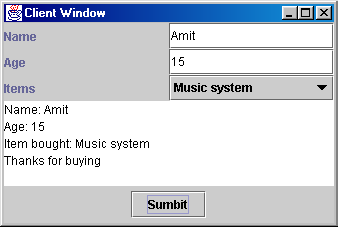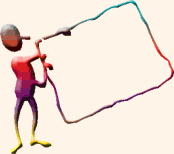 Figure 9.1 Figure 9.1

A Vector is sent to the client. Since
Vector is not a remote object, a copy
of the object is made on the client. The client program sends a Customer
object to the server. Again, Customer
is not a remote object, so a copy is made on the server.
Output
 Figure 9.2 Figure 9.2

 The
java.io.Serializable Interface The
java.io.Serializable Interface
public interface Serializable{}
This interface does not define any methods or fields. It serves only
to identify the semantics of being serializable. During default serialization,
any fields marked as transient or static will not be serialized. Classes
that require special handling during the serialization and deserialization
process must implement the following methods:
private void writeObject(ObjectOutputStream
out)throws IOException
private void readObject(ObjectInputStream
in)throws IOException, ClassNotFoundException;
 The
java.io.ObjectInputStream Class The
java.io.ObjectInputStream Class
This class is used to access objects that have been written to an ObjectOutputStream.
In other words, it is used to deserialize primitive data and objects
previously written using an ObjectOutputStream.
An object is reconstructed by calling the readObject()
method of this class.
 The
java.io.ObjectOutputStream Class The
java.io.ObjectOutputStream Class
This class is used to store serialized objects. Persistent storage
of objects can be accomplished by using a file for the stream. Only
objects that support the java.io.Serializable
interface can be written to streams. The writeObject()
method is used to write an object to the stream.

Serialization is a mechanism used to convert any object into a sequence
of bytes that can be later reconstructed. The RMI system uses the object
serialization mechanism to transmit data. The java.io.Serializable
interface is used to tag objects, which can be serialized. It is important
to note that serialized objects are always copies of the original object.
|